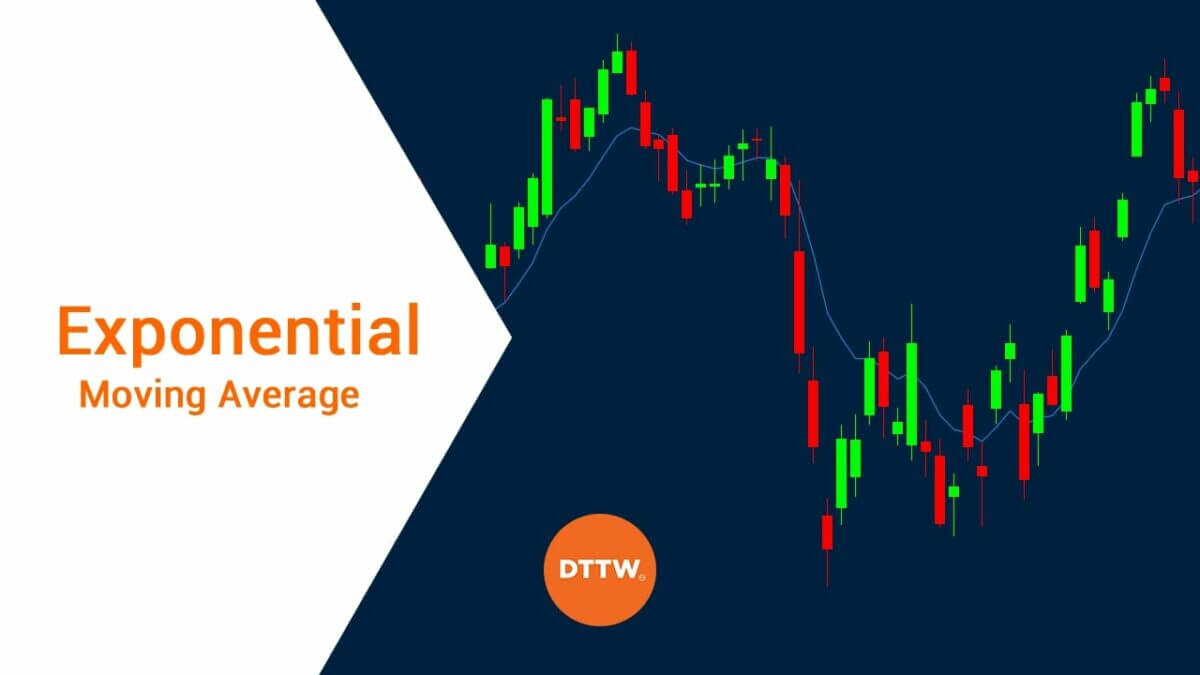
What is exponential trading, and how do traders adopt it?
The exponential moving average is one of the financial tools used to optimize the purchase and sale of assets through an in-depth study of indicators and charts. Its calculation formula distinguishes it from other indicators. Exponential trading is based on using the exponential moving averages. It’s one of the most used trading strategies.
What is a moving average?
Moving averages pinpoint the average asset price over a given time frame. There are many ways to calculate the MA. That’s why there are several types of moving averages. We call them moving because when the price moves, data are updated in the calculation and change the average price.
The moving average is probably the best-known technical indicator. It gives a smooth price curve. Thanks to this, we can see the current trend more clearly. To obtain this smoothing, we choose the number of periods to calculate the moving average. For example, in the example above, we have a 21-period moving average in orange and a 100-period moving average in red. Now let’s see how the 2 most common types of averages are calculated.
What is the exponential moving average in trading?

Investors use the moving average indicator to zoom the main trading areas and to spot the main trends.
This indicator helps to isolate the main trend in the market. Also, it serves to pinpoint the absence of a trend or the trend reversal. When it comes to moving averages, we can distinguish between simple and exponential. Using the last one in your trades means you are doing exponential trading.
In the following lines, we analyze the exponential moving average and its features versus the simple moving average. In that way, you will better know which one to choose for your trades.
What is an exponential moving average?
An exponential moving average is a financial indicator that is an integral part of technical analysis, one of the analytical methods specific to trading. The exponential moving average, also called EMA, is part of the family of moving averages.
It is called EMA in English (Exponential Moving Average) and allows an investor to apply his trading choices thanks to an optimized apprehension of market developments, in particular bullish or bearish trend reversals.
The exponential moving average seeks to confirm an already existing trend, detect a trend reversal, and allow the buyer or seller to identify the right moment for action, in this case, the management of a financial asset. It gives more importance to recent fluctuations.
How to calculate an exponential moving average?
The formula for calculating the exponential moving average remains more complex than for other moving averages. It is calculated by taking into account three elements: the multiplier, the current price and the exponential moving average of the day before.
To calculate the EMA, the multiplier must be expressed as a percentage. The current price defines the value of the asset analyzed at time T, and the exponential moving average of the day before logically takes up the value of the EMA of the previous day.
The formula for calculating the exponential moving average is, therefore, as follows: MME = MME [N-1] + M x (Price [N] – MME [N-1]). M designates the multiplier, MME [N-1] the previous day’s average, and Price [N] the current price.
Exponential trading – double and triple exponential averages
In exponential trading, you can use double and triple EMA. With a multiplier at 75% and a current price at 215, the exponential moving average could be slightly higher than 203, provided the calculation formula is applied correctly.
In this scenario, buy signals will be present when the asset price is above the EMA, and sell signals will be sent with the asset price below the EMA.
Double Exponential Moving Average
The exponential moving average can be doubled. This indicator, developed by Patrick Mulloy in 1994, smoothes the price series as well as the values of other financial indicators. In addition, it makes it possible to limit the impact of false signals and, therefore, to give indications that are more in line with reality.
Triple Exponential Moving Average
Finally, there is an additional calculation formula to define the triple exponential moving average. Created by Patrick Mulloy, the triple MME is based on a calculation formula that is similar to that of the double MME. The triple exponential moving average is an alternative to classic moving averages. It is also used for straightening purposes.
If you are wondering what are the best moving averages for swing trading, according to experts, you can’t beat the 20-day or 50-day EMA.
How to use the exponential moving average

The time frame
The period varies depending on the market and the trader. It is, therefore, necessary to identify the moving averages having the best interactions with the market.
Set the trend
The advantage of moving averages is that they allow you to see the trend at a glance. Below the MA(100), we are in a downtrend, and above it, we are in an uptrend. It will therefore be possible to choose in which direction to orient its positions during the day thanks to this average.
Visualizing the trend of an asset is relatively simple with moving averages:
An uptrend will be characterized by a rising moving average and is most often associated with a price above the moving average.
A downtrend will be characterized by a falling moving average and is most often associated with a price below the moving average.
Get support and resistance levels.
Exponential moving averages are also used by some traders to visualize key price areas:
A support price: when prices reach the EMA or cross it in an uptrend, this can indicate an upcoming rebound.
Resistance: when prices reach the EMA or the cross in a downtrend, this may indicate an upcoming relapse.
Find entry points
The crossing of two moving averages in the short and long term can indicate a change in trend and could open a position. For example, if the moving average of 21 breaks up the moving average of 100, we could see a buy signal there. In reality, these signals are not very reliable. The moving averages being calculated in the past, the signals, therefore, have a delay, and the crossovers arrive when the reversal of the trend is already well advanced.
Bounces off moving averages can be good entry points in the direction of the current trend. Moving averages act as resistances.
Exponential trading and cross-based trading system

Some trading strategies using moving averages are based on crossings, also called crossovers, with prices or another moving average:
- When prices cross above the moving average, it indicates a potential buy signal.
- When prices cross below the moving average, it indicates a potential sell signal.
- When a short moving average crosses above the long moving average, it indicates a potential buy signal. This graphic figure is often called a golden cross.
- When a short moving average crosses below the long moving average, it indicates a potential sell signal. This graphic figure is often called a death cross.
Advantages of exponential trading using EMA indicator
- Trading strategy popular with traders of all levels that can be used in all financial markets.
- Exponential moving averages are easy to understand and to integrate into a trading system, not to mention that they adapt to all types of trading (scalping, day trading, swing trading, position trading).
- The main trend is quickly visualized according to the position of the prices in relation to the moving average.
- Prices tend to react to contact with a moving average, making it a useful tool for determining key price areas.
- A trading strategy based on moving averages can take advantage of relevant buy and sell signals. In addition, the indicator can also allow you to better manage your trading positions via protective stock market orders such as stop-losses.
- Moving averages are used in the construction of other indicators like MACD or Bollinger Bands.
Limitations of EMA

Using EMA in your exponential trading strategy is very useful. However, just like any other indicator, this one has its disadvantages and limitations.
Regarding EMA, the limitation consists of lagging since the indicator relies on past price movement. All moving averages have one major drawback, which is that they are lagging indicators.
Since moving averages are based on past data, they experience a time lag before reflecting a change in trend. A stock’s price can fluctuate wildly before a moving average can indicate a change in trend. A short-term moving average suffers from less lag than a long-term moving average.
Conclusion
The moving average is probably the best-known indicator. It is excellent for knowing clearly what the market trend is. The crossing of several moving averages can indicate a trend reversal. However, these crossings are late, and the trend will have already been well underway. We recommend using this indicator more for trend following and not for opening positions on reversals.
The exponential moving average seeks to confirm an already existing trend, detect a trend reversal, and allow the buyer or seller to identify the right moment for action, in this case, the management of a financial asset. It gives more importance to recent fluctuations.




